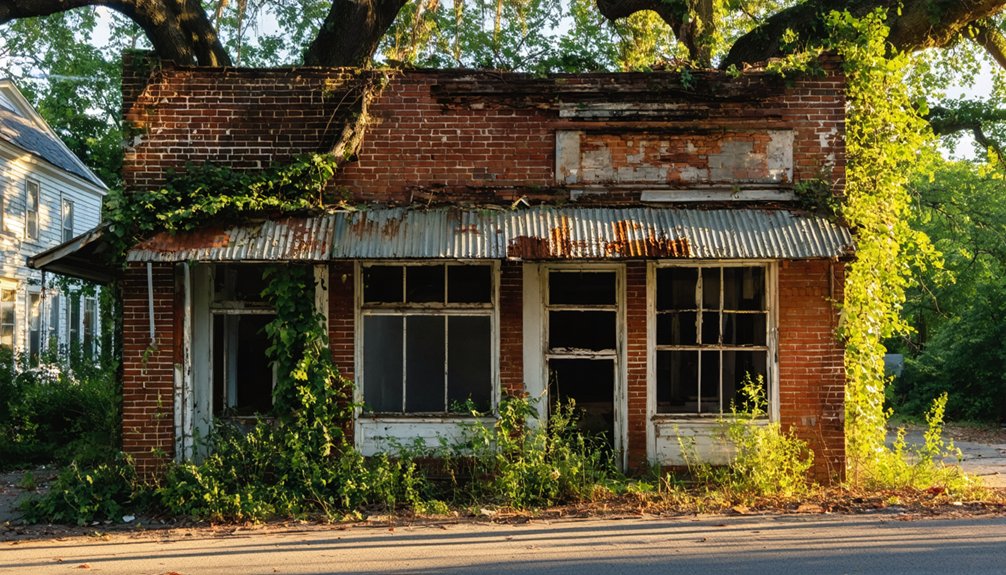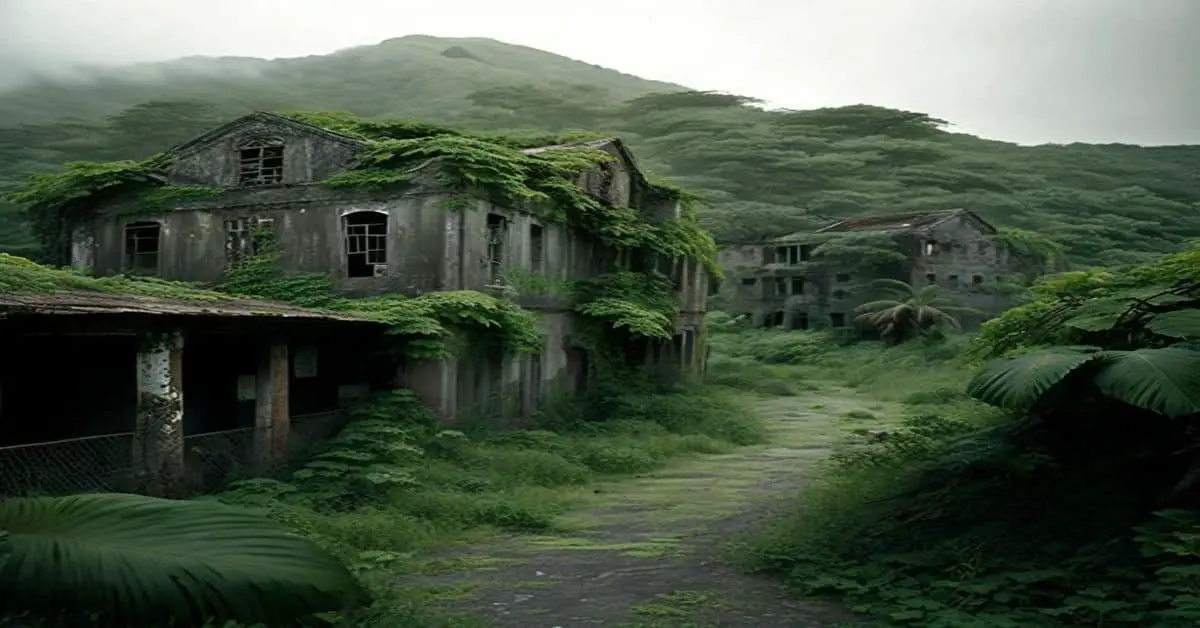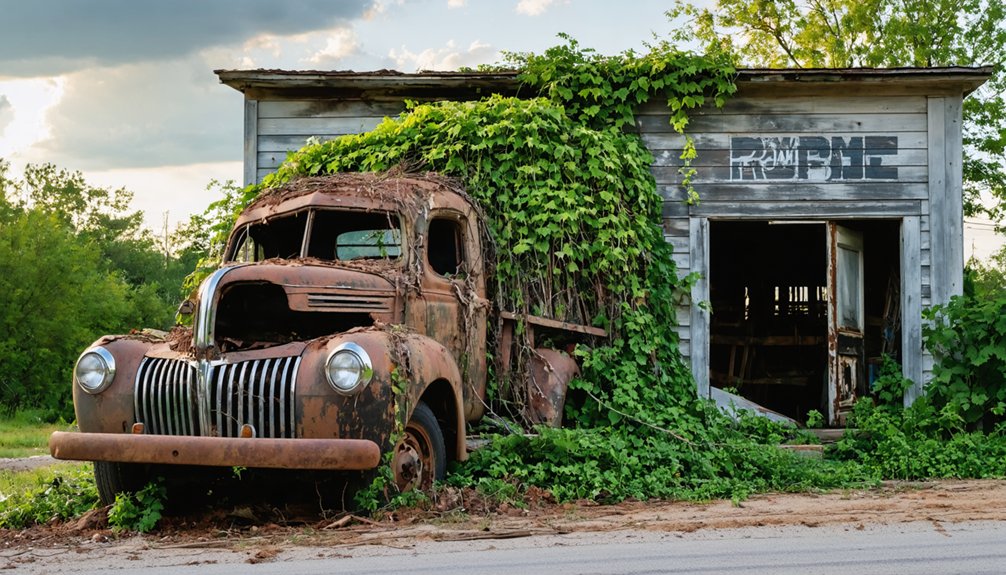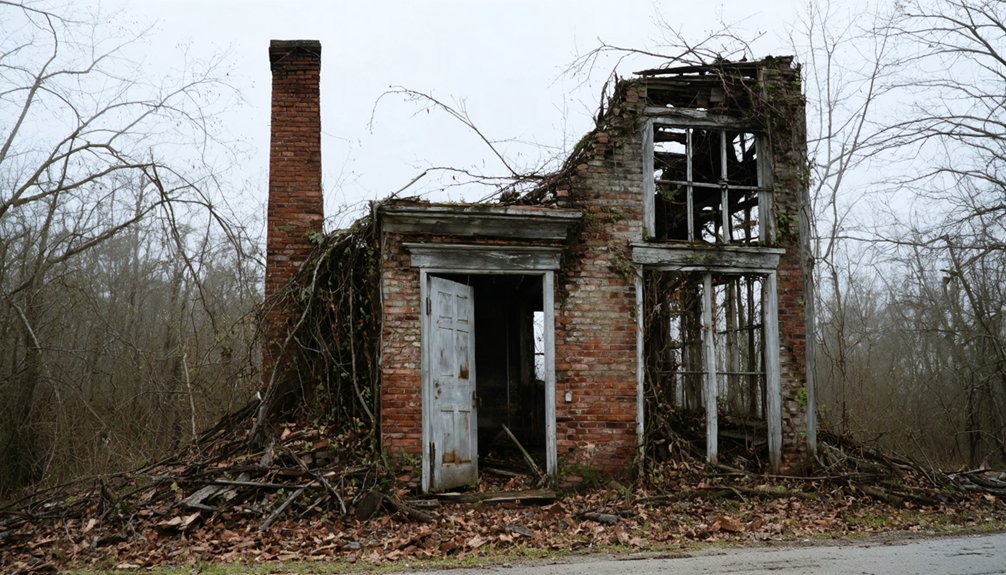You’ll find Clarkesville’s ghost town story in southern Alabama, where it served as Clarke County’s first county seat from 1820 to 1831. While no visible ruins remain today, this pioneer settlement once bustled with government activity around its log courthouse. When residents successfully petitioned to move the county seat to what’s now Grove Hill, Clarkesville gradually faded into history. Its fascinating transformation from administrative hub to abandoned town reveals deeper insights into Alabama’s early statehood period.
Key Takeaways
- Clarkesville was Clarke County’s first county seat in 1820 but became a ghost town after losing this status to Grove Hill in 1831.
- Located within three miles of Clarke County’s center, the town featured a log courthouse for local governance and justice administration.
- The town’s complete abandonment occurred due to economic stagnation and population decline following the relocation of the county seat.
- No visible remnants or marked ruins of Clarkesville exist today, though it was historically situated in southern Alabama’s river country.
- The ghost town’s decline primarily resulted from losing its administrative importance, unlike other ghost towns that failed for different reasons.
Early Days as Clarke County’s Administrative Hub
After Alabama achieved statehood in 1819, the state legislature established Clarkesville as Clarke County’s first county seat in 1820, positioning it within three miles of the county’s geographic center.
Newly-formed Alabama strategically placed its Clarke County seat of Clarkesville near the geographic heart of the region in 1820.
You’ll find that early governance centered around a simple log courthouse, where county commissioners managed local affairs and courts dispensed justice during a significant time in Alabama’s frontier development.
The settlement dynamics of Clarkesville reflected the complex relationships between Creek and Choctaw nations and European-American settlers.
As you explore this period, you’ll discover how the town served as a vital administrative hub where William Barrett Travis and other notable figures practiced law.
The town’s strategic location near the Tombigbee and Alabama Rivers made it an important center for trade and political gatherings in the newly organized county. This area required careful disambiguation from other Clarke Counties across the United States.
The county would eventually relocate its administrative functions to Grove Hill in 1831, marking the beginning of Clarkesville’s decline.
From County Seat to Vanished Settlement
Despite its early prominence as Clarke County’s administrative center, Clarkesville’s influence began to wane when county residents successfully petitioned to move the seat of government to Macon (later Grove Hill) in 1831.
The loss of civic importance triggered a gradual but irreversible decline that would ultimately lead to the town’s complete disappearance. Named after Governor John Clark, this settlement shared its namesake with other towns that had more enduring success.
County commissioners established the town’s initial governance structure on December 13, 1819.
You can trace Clarkesville’s evolution from thriving settlement to ghost town through these key developments:
- Population decline accelerated after administrative functions moved to Grove Hill
- The town failed to diversify its economy to compensate for lost government activity
- Surrounding communities drew away remaining residents and commerce
- By the late 1800s, Clarkesville had vanished from regional maps entirely
Today, only a modern community one mile from the original site preserves the name Clarksville, though it’s distinct from the historic settlement.
Geographic Legacy and Modern Location
While the exact location of Clarkesville’s original settlement remains elusive today, historical records place this former Clarke County seat in southern Alabama’s rich river country near the Mississippi border.
You’ll find that its geographic significance stemmed from its position within the region’s extensive waterway network, which facilitated early trade and transportation.
Unlike some of Alabama’s other ghost towns, you won’t find any modern remnants or marked ruins at Clarkesville’s site.
The town served as county seat until 1831, after which its influence began to decline significantly.
Like many settlements of its era, Clarkesville relied heavily on river crossings for commerce and growth.
The town’s physical traces have vanished into Clarke County’s rural landscape of farms and forests.
Though Grove Hill now serves as the county seat, Clarkesville’s legacy lives on in the region’s development patterns.
If you’re exploring the area, you’ll notice how the shift of power from Clarkesville helped shape today’s local communities.
Rise and Fall During Alabama’s Early Statehood
You’ll find Clarkesville’s story deeply rooted in Alabama’s early statehood, as the town emerged in 1819 when state legislators strategically selected it to serve as Clarke County’s first administrative center.
While you might’ve expected the carefully chosen location to guarantee success, the town’s role as a government hub couldn’t overcome its lack of transportation advantages and growing competition from other settlements.
Like many port towns along Alabama’s rivers, Clarkesville struggled to maintain its economic vitality through changing times.
The town ultimately lost its position to Macon, later renamed Grove Hill, in 1831 when county residents became dissatisfied with the location.
Early Administrative Hub
Soon after Alabama achieved statehood in 1819, Clarkesville emerged as the first county seat of Clarke County, serving as a significant administrative hub during the region’s formative years.
Clarkesville’s governance reflected the democratic spirit of the frontier, operating under a constitutional framework that rejected harsh restrictions common in neighboring states. The area’s rich history includes early settlements of Creeks and Choctaws who inhabited the region before Alabama’s statehood. The town’s development coincided with a period when land-seeking settlers poured into the territory, driven by “Alabama fever.”
You’ll find that the town’s early infrastructure supported essential administrative functions:
- Administrative buildings managed land records and legal proceedings
- Strategic location near rivers facilitated trade and political operations
- Central meeting place for county residents to conduct official business
- Hub for implementing state policies and managing territorial disputes
Despite its importance in shaping early Alabama’s administrative landscape, Clarkesville’s influence waned by 1831 when the county seat relocated to Grove Hill, marking the beginning of its decline into a ghost town.
Government Center’s Strategic Selection
As Alabama established its statehood in 1819, the legislature enacted strict guidelines requiring county seats to be positioned within three miles of their geographic centers, leading to Clarkesville’s selection as Clarke County’s first administrative hub.
You’ll find that this strategic planning reflected the young state’s commitment to balanced regional representation.
Clarkesville’s founding in 1820 capitalized on its proximity to major waterways and existing settlements, making it an ideal choice within the historical context of frontier development. The site’s natural features offered advantages for transportation and defense, particularly essential during ongoing territorial disputes.
While the location met the legislature’s geographic requirements, you’ll discover that Clarkesville’s promise as a government center would ultimately be undermined by limited infrastructure and challenging terrain.
Power Shift Sparks Decline
The political winds shifted dramatically against Clarkesville in 1831 when mounting dissatisfaction led to the relocation of Clarke County’s seat to Macon, later renamed Grove Hill.
This transfer of political influence devastated Clarkesville’s prominence and triggered a cascade of decline that would ultimately seal the town’s fate.
As you examine Clarkesville’s downfall, you’ll find four key factors that accelerated its demise:
- Loss of government functions sparked immediate economic stagnation
- Population steadily decreased as residents moved toward the new county seat
- Lack of major industries or resources prevented economic diversification
- Limited transportation infrastructure isolated the town from regional trade
Without its administrative role and facing mounting challenges, Clarkesville gradually faded from prominence until it vanished from maps entirely by the late 1800s.
Comparing Clarkesville’s Fate With Other Ghost Towns
While many ghost towns in Alabama faded into history due to similar economic pressures, Clarkesville’s decline presents a unique case study when compared to its contemporaries. Unlike Balkum, which disappeared after losing its post office, or Battelle, which succumbed to Birmingham’s industrial competition, Clarkesville’s downfall stemmed primarily from losing its status as a county seat to Grove Hill in 1831.
You’ll find this distinction particularly significant when examining ghost town comparisons across the state.
The economic decline that followed Clarkesville’s power shift echoes through other abandoned settlements, yet its role as a former administrative center sets it apart.
While towns like Monroe simply faded away in the 1870s, Clarkesville’s transformation from a seat of government to a ghost town illustrates how quickly political changes can reshape a community’s destiny.
Historical Significance in Modern Times
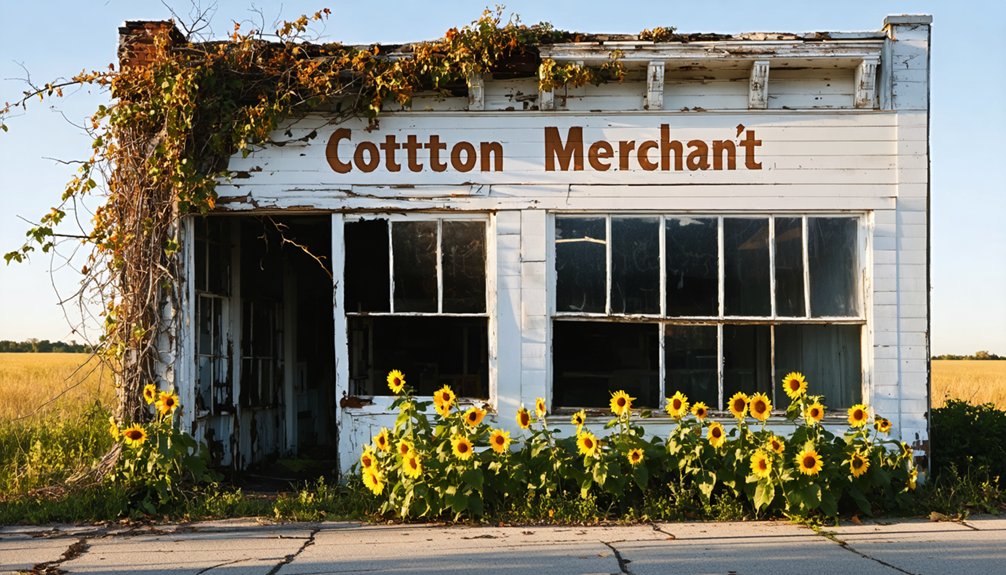
Modern visitors to Clarke County mightn’t realize they’re walking through what was once a thriving administrative center, yet Clarkesville’s historical footprint remains deeply embedded in Alabama’s cultural landscape.
As you explore the area’s cultural heritage, you’ll discover that Clarkesville’s legacy continues to shape our understanding of early Alabama governance in four key ways:
- It demonstrates how pioneer-era settlements adapted to changing administrative needs.
- It serves as a compelling case study for historical tourism initiatives.
- It provides valuable insights into 19th-century county development patterns.
- It illustrates the profound impact that governmental decisions can have on community survival.
Today, while physical structures no longer stand, Clarkesville’s story enriches local historical narratives and offers unique perspectives on Alabama’s developmental journey from territory to statehood.
Frequently Asked Questions
What Happened to the Original Residents of Clarkesville After 1831?
Like rats leaving a sinking ship, you’ll find the residents’ migration followed community decline as they packed up for Macon/Grove Hill, seeking better economic opportunities after losing county seat status.
Were There Any Notable Buildings or Landmarks in Clarkesville?
You’d find the courthouse dominated the town layout during its heyday, but all historic architecture has vanished. The nearby burial site of Alabama’s fourth governor remains the only notable landmark today.
Why Was Clarkesville Specifically Chosen for the Original County Seat?
You’ll find the county selection was purely practical – state-appointed commissioners chose it for being within 3 miles of Clarke County’s center, following Alabama’s legal requirements for geographical centrality.
What Natural Disasters or Events May Have Contributed to Clarkesville’s Abandonment?
You can’t definitively link any natural catastrophes to Clarkesville’s decline, though environmental changes in the coastal plain region may have played a role in its gradual abandonment over time.
Are There Any Surviving Documents or Records From Clarkesville’s Active Period?
Ever wonder what secrets lie in dusty archives? You’ll find limited historical archives and census records from Clarkesville’s heyday, with most documentation preserved through the Clarke County Historical Society and local genealogical collections.
References
- https://digitalalabama.com/alabama-ghost-towns/clarkesville-alabama-ghost-town/14011/
- https://digitalalabama.com/alabama-ghost-towns/alabama-ghost-towns/9449
- https://en.wikipedia.org/wiki/List_of_ghost_towns_in_Alabama
- https://kellykazek.com/2020/04/10/looking-for-the-history-of-this-little-ghost-town-in-north-alabama-can-you-help/
- https://clarkecountyal.com/clarkeco-history/
- https://en.wikipedia.org/wiki/Clarke_County
- https://encyclopediaofalabama.org/article/clarke-county/
- https://www.ruralswalabama.org/counties/clarke/page/2/
- https://thereevesproject.org/data/tiki-index.php?page=AL_County_Clarke
- https://www.clarkemuseum.com/html/markers.html
